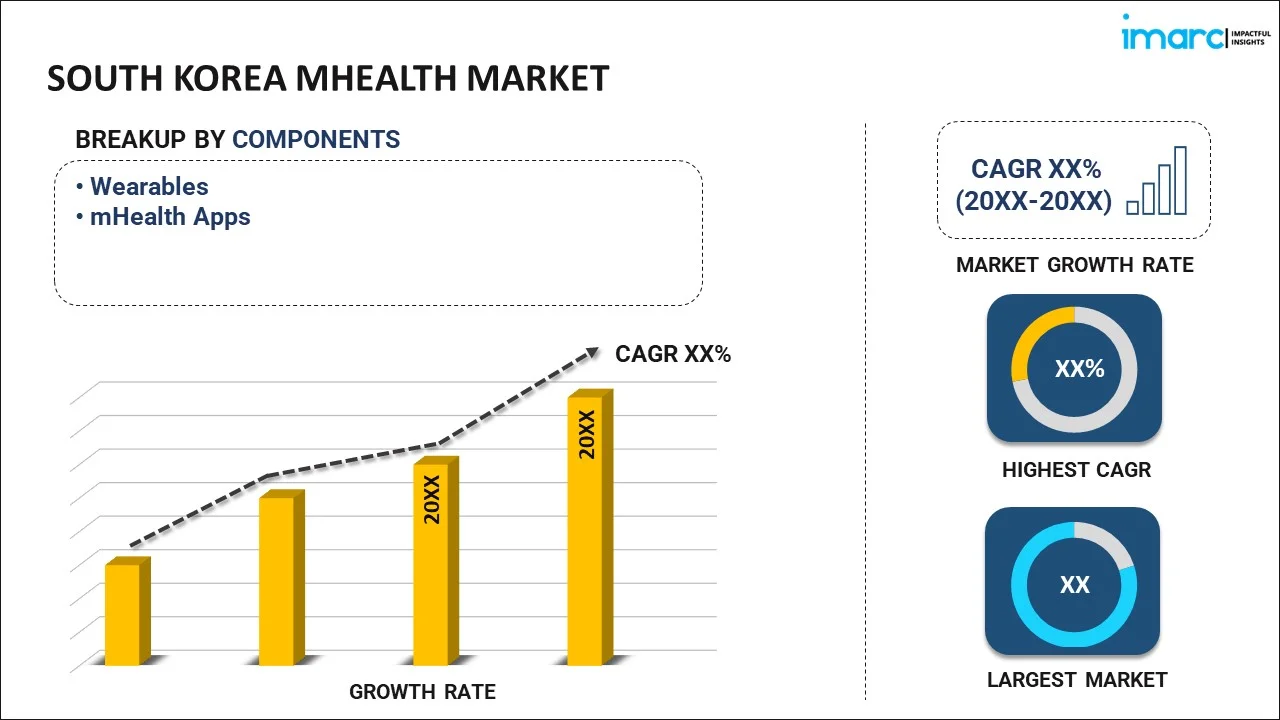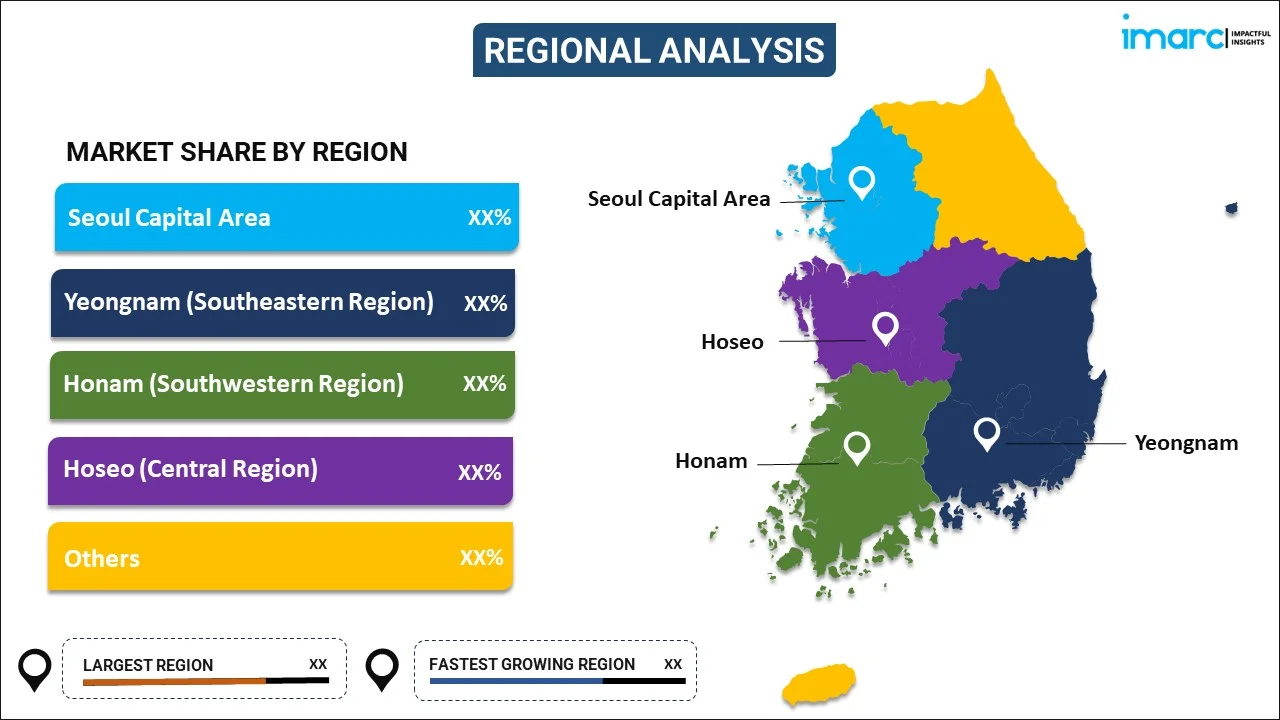
South Korea mHealth Market Report by Component (Wearables, mHealth Apps), Service (Monitoring Services, Diagnosis Services, Healthcare Systems Strengthening Services, Treatment Services, and Others), Participant (mHealth Application Companies, Pharmaceuticals Companies, Hospitals, Health Insurance Companies, and Others), and Region 2025-2033
Market Overview:
South Korea mHealth market size is projected to exhibit a growth rate (CAGR) of 20.05% during 2025-2033. The widespread adoption of home-based patient monitoring services by the geriatric population is primarily driving the market growth across the country.
|
Report Attribute
|
Key Statistics
|
|---|---|
|
Base Year
|
2024 |
|
Forecast Years
|
2025-2033 |
|
Historical Years
|
2019-2024
|
| Market Growth Rate (2025-2033) | 20.05% |
Mobile health (mHealth) represents a varied sector within electronic health (eHealth) that leverages mobile devices and wireless infrastructure to gather patient data. This collected information aids in generating precise results crucial for diagnosing and treating various medical conditions. mHealth further plays a pivotal role in enhancing medication adherence and communication, facilitating remote patient monitoring, and empowering patients to securely send messages, connect with service providers, and schedule appointments. Consequently, its applications extend to healthcare supply chain management, providing support in diagnostics and treatment, monitoring and managing chronic diseases, and fostering increased health awareness among individuals.
South Korea mHealth Market Trends:
In South Korea, the mHealth market is driven by a convergence of technological advancements, a tech-savvy population, and a proactive healthcare system. Additionally, the country's robust mobile infrastructures and widespread smartphone usage contribute to the adoption of mHealth solutions. Besides this, the escalating demand for remote healthcare services has surged, especially in the wake of events, accelerating the emerging trend of virtual consultations, remote patient monitoring, and mobile health applications, which is acting as another significant growth-inducing factor. Moreover, favorable government initiatives promoting digital healthcare and telemedicine play a significant role in shaping the mHealth landscape, thereby positively influencing the regional market. South Korea's aging population and a growing awareness of health and wellness further fuel the acceptance of mHealth solutions. Furthermore, the elevating integration with wearables and smart devices enhances the accessibility and effectiveness of healthcare services, which is bolstering the market growth across the country. As South Korea continues to embrace digital transformation in the medical sector, the mHealth market reflects a dynamic interplay of technology, regulatory support, and evolving consumer preferences. At last, leading manufacturers are using innovative technologies to support the healthcare industry, which is expected to fuel the South Korea mHealth market over the forecasted period.
South Korea mHealth Market Segmentation:
IMARC Group provides an analysis of the key trends in each segment of the market, along with forecasts at the country level for 2025-2033. Our report has categorized the market based on component, service, and participants.
Component Insights:

- Wearables
- Blood Pressure Monitors
- Blood Glucometer
- Pulse Oximeter
- Neurological Monitors
- Others
- mHealth Apps
- Medical Apps
- Fitness Apps
The report has provided a detailed breakup and analysis of the market based on the component. This includes wearables (blood pressure monitors, blood glucometer, pulse oximeter, neurological monitors, and others) and mHealth apps (medical apps and fitness apps).
Service Insights:
- Monitoring Services
- Diagnosis Services
- Healthcare Systems Strengthening Services
- Treatment Services
- Others
A detailed breakup and analysis of the market based on the service also been provided in the report. This includes monitoring services, diagnosis services, healthcare systems strengthening services, treatment services, and others.
Participants Insights:
- mHealth Application Companies
- Pharmaceuticals Companies
- Hospitals
- Health Insurance Companies
- Others
The report has provided a detailed breakup and analysis of the market based on the participants. This includes mHealth application companies, pharmaceuticals companies, hospitals, health insurance companies, and others.
Regional Insights:

- Seoul Capital Area
- Yeongnam (Southeastern Region)
- Honam (Southwestern Region)
- Hoseo (Central Region)
- Others
The report has also provided a comprehensive analysis of all the major regional markets, which include Seoul Capital Area, Yeongnam (Southeastern Region), Honam (Southwestern Region), Hoseo (Central Region), and Others.
Competitive Landscape:
The market research report has also provided a comprehensive analysis of the competitive landscape. Competitive analysis such as market structure, key player positioning, top winning strategies, competitive dashboard, and company evaluation quadrant has been covered in the report. Also, detailed profiles of all major companies have been provided.
South Korea mHealth Market Report Coverage:
| Report Features | Details |
|---|---|
| Base Year of the Analysis | 2024 |
| Historical Period | 2019-2024 |
| Forecast Period | 2025-2033 |
| Units | Billion USD |
| Scope of the Report | Exploration of Historical and Forecast Trends, Industry Catalysts and Challenges, Segment-Wise Historical and Predictive Market Assessment:
|
| Components Covered |
|
| Services Covered | Monitoring Services, Diagnosis Services, Healthcare Systems Strengthening Services, Treatment Services, Others |
| Participants Covered | mHealth Application Companies, Pharmaceuticals Companies, Hospitals, Health Insurance Companies, Others |
| Regions Covered | Seoul Capital Area, Yeongnam (Southeastern Region), Honam (Southwestern Region), Hoseo (Central Region), Others |
| Customization Scope | 10% Free Customization |
| Post-Sale Analyst Support | 10-12 Weeks |
| Delivery Format | PDF and Excel through Email (We can also provide the editable version of the report in PPT/Word format on special request) |
Key Questions Answered in This Report:
- How has the South Korea mHealth market performed so far and how will it perform in the coming years?
- What has been the impact of COVID-19 on the South Korea mHealth market?
- What is the breakup of the South Korea mHealth market on the basis of component?
- What is the breakup of the South Korea mHealth market on the basis of service?
- What is the breakup of the South Korea mHealth market on the basis of participants?
- What are the various stages in the value chain of the South Korea mHealth market?
- What are the key driving factors and challenges in the South Korea mHealth?
- What is the structure of the South Korea mHealth market and who are the key players?
- What is the degree of competition in the South Korea mHealth market?
Key Benefits for Stakeholders:
- IMARC’s industry report offers a comprehensive quantitative analysis of various market segments, historical and current market trends, market forecasts, and dynamics of the South Korea mHealth market from 2019-2033.
- The research report provides the latest information on the market drivers, challenges, and opportunities in the South Korea mHealth market.
- Porter's five forces analysis assist stakeholders in assessing the impact of new entrants, competitive rivalry, supplier power, buyer power, and the threat of substitution. It helps stakeholders to analyze the level of competition within the South Korea mHealth industry and its attractiveness.
- Competitive landscape allows stakeholders to understand their competitive environment and provides an insight into the current positions of key players in the market.
Need more help?
- Speak to our experienced analysts for insights on the current market scenarios.
- Include additional segments and countries to customize the report as per your requirement.
- Gain an unparalleled competitive advantage in your domain by understanding how to utilize the report and positively impacting your operations and revenue.
- For further assistance, please connect with our analysts.
 Inquire Before Buying
Inquire Before Buying
 Speak to an Analyst
Speak to an Analyst
 Request Brochure
Request Brochure
 Request Customization
Request Customization




.webp)




.webp)












